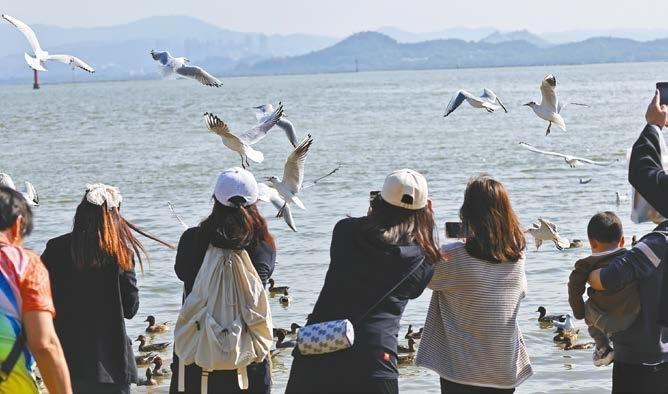In late October, about 20 or 30 black-faced spoonbills were spotted at the Guangdong Neilingding Futian National Nature Reserve, marking the start of Shenzhen's migratory bird season.

Black-faced spoonbills observed at the Guangdong Neilingding Futian National Nature Reserve. File photo
Footage from the reserve's 4K panoramic cameras shows three black-faced spoonbills standing quietly by a fishpond at dusk. Their white plumage and distinctive black, spoon-shaped bills formed elegant silhouettes in the dim light, highlighting the wetland's tranquil beauty as they rested.
As a globally endangered species, black-faced spoonbills require high-quality water and abundant food resources. Their presence is often regarded as a barometer of wetland ecological health. With their arrival, Shenzhen's prime bird-watching season is beginning.
According to the Shenzhen Bird Watching Society, the best time for bird-watching in Shenzhen is from November through February. During this period, sites such as Shenzhen Bay, Futian Mangrove Nature Reserve, and OCT Wetland can host nearly 100,000 migratory birds across more than 200 species, including black-faced spoonbills, Eurasian curlews, and pied avocets — creating spectacular scenes of large flocks in flight.

Visitors enjoy watching the birds at Shenzhen Bay Park. Liu Xudong
Bird-watching tips:
Early morning is the best time. Be patient, keep quiet, and maintain a safe distance to avoid disturbing birds. Do not feed the birds. Check tide levels in advance; birds are most active when the tide is between about 0.5-1.2 meters above sea level. Do not walk onto mudflats, which can startle birds and be dangerous.
Guangdong Neilingding Futian National Nature Reserve 广东内伶仃福田国家级自然保护区
At the reserve, you may see species such as terek sandpiper, lesser sand plovers, greater sand plover, Asian dowitcher, black-faced spoonbill, pied avocet, black-winged stilt, and gray heron. Use bird-watching pavilions and boats for better viewing angles.
Booking: WeChat miniprogram "内伶仃福田自然保护区"
Metro: Line 1 to Qiaocheng East Station (侨城东站), Exit C1
Shenzhen Bay Park 深圳湾公园
Bird-watching at Shenzhen Bay depends on the tides. More mudflats are exposed when the tide is around one meter or lower, making it an ideal time to see larger numbers of birds.
Metro: Line 9 to Shenzhen Bay Park Station (深圳湾公园站), Exit D2






